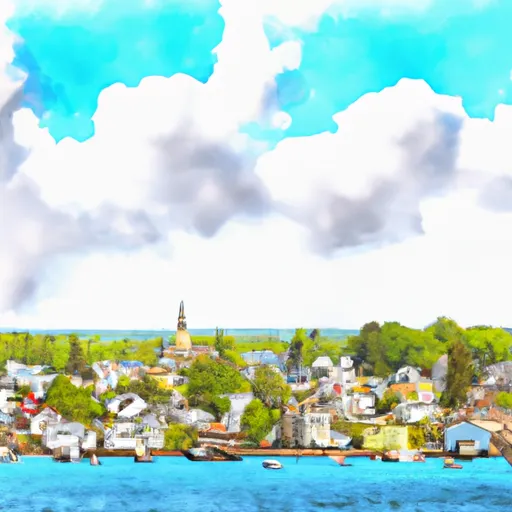-
 Snoflo Premium
Snoflo Premium
Get unlimited access to all our content
With no Ad interruptions! - Start Your Free Trial Login with existing account
Lake-Leelanau
Eden Index
Climate
7.0
•
Recreation
6.0
•
Community
2.0
•
Safeguard
5.4/10

Lake Leelanau is a charming and picturesque community located in Leelanau County, Michigan. The area is known for its stunning natural beauty, pristine waters, and diverse outdoor recreational opportunities.
Lake Leelanau has a humid continental climate with warm summers and cold winters. The average temperature in summer ranges from 70°F to 80°F, while winter temperatures can drop to below freezing. The area experiences moderate rainfall throughout the year, creating an ideal environment for lush vegetation and vibrant wildlife.
As for hydrology constituents, Lake Leelanau is a glacial lake covering approximately 8,608 acres. It is divided into two distinct sections, North Lake Leelanau and South Lake Leelanau, and is fed by various tributaries and streams. The lake is known for its crystal-clear waters, making it perfect for various water activities such as boating, fishing, swimming, and kayaking.
Outdoor recreation opportunities in Lake Leelanau are abundant. The lake offers excellent fishing opportunities, with various species including bass, perch, pike, and walleye. The surrounding area provides numerous hiking and biking trails, allowing visitors to explore the picturesque landscapes and enjoy breathtaking views. Additionally, the lake's calm waters make it a popular spot for paddleboarding and canoeing.
In summary, Lake Leelanau, Michigan, offers a delightful climate, pristine hydrology constituents, and a wide range of outdoor recreation opportunities, making it an ideal destination for nature lovers and adventure seekers alike.
What is the Eden Index?
The Snoflo Eden Index serves as a comprehensive rating system for regions, evaluating their desirability through a holistic assessment of climate health, outdoor recreation opportunities, and natural disaster risk, acknowledging the profound impact of these factors on livability and well-being.
Climate Health Indicator (CHI): 7.0
Lake-Leelanau receives approximately
824mm of rain per year,
with humidity levels near 80%
and air temperatures averaging around
8°C.
Lake-Leelanau has a plant hardyness factor of
6, meaning
plants and agriculture in this region thrive during a short period during spring and early summer. Most
plants will die off during the colder winter months.
By considering the ideal temperature range, reliable water supplies, clean air, and stable seasonal rain or snowpacks, the Climate Health Indicator (CHI) underscores the significance of a healthy climate as the foundation for quality living.
A healthy climate is paramount for ensuring a high quality of life and livability in a region, fostering both physical well-being and environmental harmony. This can be characterized by ideal temperatures, reliable access to water supplies, clean air, and consistent seasonal rain or snowpacks.
Weather Forecast
Streamflow Conditions
Northeastern Lake Michigan
Area Rivers
Northeastern Lake Michigan
Snowpack Depths
Northeastern Lake Michigan
Reservoir Storage Capacity
Northeastern Lake Michigan
Groundwater Levels
Recreational Opportunity Index (ROI): 6.0
The Recreational Opportunity Index (ROI) recognizes the value of outdoor recreational options, such as parks, hiking trails, camping sites, and fishing spots, while acknowledging that climate plays a pivotal role in ensuring the comfort and consistency of these experiences.
Access to outdoor recreational opportunities, encompassing activities such as parks, hiking, camping, and fishing, is crucial for overall well-being, and the climate plays a pivotal role in enabling and enhancing these experiences, ensuring that individuals can engage in nature-based activities comfortably and consistently.
Camping Areas
| Campground | Campsites | Reservations | Toilets | Showers | Elevation |
|---|---|---|---|---|---|
| Natalie - State Forest | 12 | 722 ft | |||
| Headquarters Lake - State Forest | 8 | 740 ft | |||
| Blind Sucker 2 - State Forest | 32 | 635 ft | |||
| Blind Sucker 1 - State Forest | 13 | 634 ft | |||
| Perch Lake - State Forest | 25 | 735 ft | |||
| Pretty Lake - State Forest | 27 | 761 ft | |||
| High Bridge - State Forest | 7 | 720 ft | |||
| Lake Superior - State Forest | 18 | 627 ft | |||
| Holland Lake - State Forest | 15 | 760 ft | |||
| Muskallonge Lake State Park | 170 | 644 ft |
Nearby Ski Areas
Catastrophe Safeguard Index (CSI):
The Catastrophe Safeguard Index (CSI) recognizes that natural disaster risk, encompassing floods, fires, hurricanes, and tornadoes, can drastically affect safety and the overall appeal of an area.
The level of natural disaster risk in a region significantly affects safety and the overall livability, with climate change amplifying these risks by potentially increasing the frequency and intensity of events like floods, fires, hurricanes, and tornadoes, thereby posing substantial challenges to community resilience and well-being.
Community Resilience Indicator (CRI): 2.0
The Community Resilience Indicator (CRI) recognizes that education, healthcare, and socioeconomics are crucial to the well-being of a region. The CRI acknowledges the profound impact of these elements on residents' overall quality of life. By evaluating educational resources, healthcare accessibility, and economic inclusivity, the index captures the essential aspects that contribute to a thriving community, fostering resident satisfaction, equity, and social cohesion.

